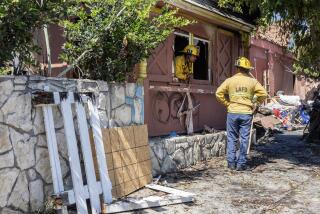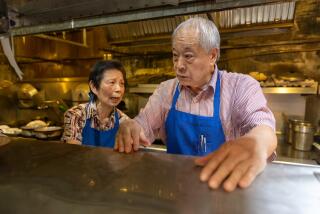A Loving Shrine to McDonald’s That McDonald’s Shuns
Not much is left of the original burger stand and golden arches that triggered a fast-food revolution and launched the largest restaurant chain in the world.
The eatery that the McDonald brothers operated at 14th and North E streets in San Bernardino more than 50 years ago was razed and replaced by a music store that took over the corner in 1974.
More than two decades later, McDonald’s returned -- unofficially.
The storefront is now the home of a quirky museum that pays tribute to the burger empire that gave the world the Big Mac, McNuggets and the Happy Meal. Inside, visitors can see -- free of charge -- more than 5,000 pieces of kitschy McDonald’s memorabilia, including Happy Meal toys, commemorative plates, dolls and 1950s milkshake machines and fryers. The walls are adorned with handwritten letters from a few of the first fry cooks and car hop girls at McDonald’s.
What the museum does not have is the blessing or financial support of McDonald’s Corp., which operates an officially sanctioned museum in Des Plaines, Ill., where McDonald’s founder Ray Kroc opened the first franchise in 1955.
The San Bernardino museum is the brainstorm of Albert Okura, a businessman who owns and runs Juan Pollo, a chain of Mexican rotisserie chicken restaurants in Southern California. Okura built the museum as a tribute to Kroc, his longtime hero. Still, he has had a couple of clashes with McDonald’s Corp. over his use of the McDonald’s trademark.
Those disputes have since been settled, and Okura and McDonald’s now maintain a frosty coexistence.
Asked to comment about Okura’s museum, the corporation issued a terse statement:
“The museum in San Bernardino, which displays McDonald’s historic information and memorabilia, is not in any way affiliated with the McDonald’s Corporation. McDonald’s has the right, by law, to protect our trademark.”
McDonald’s officials declined to comment further on the museum, except to say that anyone looking for historical information about the company should visit the McDonald’s website.
Okura, an energetic entrepreneur who has been in the fast-food business since he was a teenager, said he wasn’t sure why he originally wanted to buy the former McDonald’s property in a working-class neighborhood on the city’s east side.
But he said that, as a longtime admirer of Kroc, he couldn’t let the historic parcel fall into anybody else’s hands when it came on the market in 1998.
“I think it’s my destiny to own this property,” Okura said as he leaned on one of his crowded display cases at the museum.
Later, when an article in a local newspaper erroneously reported that Okura planned to build a museum on the site, he decided the idea made sense.
As word spread, former McDonald’s employees and customers began donating memorabilia. Toys, posters, statues and stuffed dolls began arriving by the bagful.
Okura operates all 27 Juan Pollo restaurants in Southern California but has yet to franchise the business, saying he is still laying the groundwork for his worldwide expansion.
He acknowledges that the McDonald’s museum helps promote his restaurants, especially since the Juan Pollo headquarters is in the same building. He also offers museum visitors a historical fact sheet on McDonald’s that has the Juan Pollo logo and phone number at the bottom.
Okura and McDonald’s Corp. clashed four years ago when he launched a website for the museum that included a link to the Juan Pollo site. Okura said he didn’t know about the link. Word reached the corporate lawyers at McDonald’s who wrote a short letter warning Okura that he was forbidden to profit from the McDonald’s name.
Okura removed the Web link. McDonald’s Corp. has also warned Okura not to refer to his collection of memorabilia as a “McDonald’s Museum.” Now he is careful to call it the “historic site of the original McDonald’s restaurant.”
“We are sort of an oddball thing to them,” he said of the corporation.
In 1940, Richard and Maurice McDonald installed a converted airdrome structure at 14th and North E and opened a neighborhood barbecue joint.
The restaurant was popular, but the brothers realized eight years later that the business would be more profitable if they focused primarily on hamburgers, so they created a production system that emphasized speed, low prices and volume. The restaurant reopened with a menu that offered 15-cent burgers and 10-cent French fries.
Twenty-eight years after opening the restaurant, the McDonald brothers sold the property to a local restaurateur who turned it into a taco stand, which closed in 1970. The building was later abandoned and razed.
A brick office building behind the restaurant, where the McDonald brothers worked, remains standing today.
In the mid-1970s, a music store was built on the site and was later purchased by the San Bernardino Civic Light Opera. In 1997, the opera went bankrupt. Okura bought the property for $130,000 in 1998 after reading about the foreclosure in a local newspaper.
Over the years, most of the museum’s visitors have been tourists who learned about the site while following Route 66, the historic byway that travels through San Bernardino.
Barbara and Donald Wood of Sun City, Ariz., stopped in recently while visiting historic sites along Route 66. Okura was on hand to give the couple a brief history of the McDonald brothers.
“They didn’t even know that McDonald’s started in San Bernardino,” Okura said afterward.
But some visitors are longtime residents who come by to relive old memories.
“When I was a teenager I came here and got hamburgers for 15 cents and fries for a dime,” said Don Miller, 61, a retired postal worker who grew up in San Bernardino and visited the museum recently. “I think it’s great to see all the old pictures that show the way people dressed back then.”
More to Read
Eat your way across L.A.
Get our weekly Tasting Notes newsletter for reviews, news and more.
You may occasionally receive promotional content from the Los Angeles Times.











